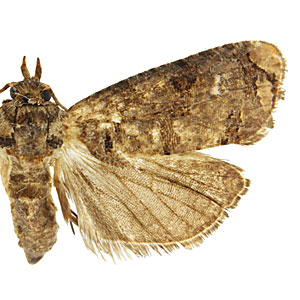Adult Recognition

FWL: 7.0-11.0 mm
Adults are grayish brown with indistinct black, brown, and gray markings. Many individuals have a black patch near the apex of the forewing that may extend to the termen. Male genitalia are characterized by a triangular cucullus with a row of dense spines. Female genitalia are characterized by a ductus bursae that is partially sclerotized and two thornlike signa.
Adults appear similar to other Grapholitini, including Cydia torostoma, which feeds on beans in Central America. A genitalic dissection may be necessary to confirm identity.
Larval Morphology

Late instar larvae are approximately 18 mm in length with a whitish abdomen.
The head, prothoracic shield,
and thoracic legs are brown. Abdominal pinacula
are large, brown, and conspicuous. An anal comb
is absent.
Larvae are similar to many species in the Cryptophlebia-Ecdytolopha group, with an enlarged
L-pinaculum on
the prothorax
that extends beneath (and usually beyond) the spiracle.
Larval damage to beans is similar to that
caused by Crocidosema aporema; however, larvae of C. aporema feed primarily on
young leaflets while those of E. fabivora feed in the stems and pods.
An anal comb
is present in C. aporema but is absent in E. fabivora.
Other bean-feeding tortricids in
South and Central America include Amorbia spp., Cydia torostoma,
Lusterala phaseolana, and Platynota spp.
Biology

Ecdytolopha fabivora completes several generations per year. In areas where host plants are available year-round, adults may be present at any time.
Females lay eggs on the leaves, petioles, stems, flowers, and pods, of soybean; oviposition behavior varies with plant age. Larvae tunnel into the petioles, stems, or pods, sometimes causing considerable damage. Larvae may also feed on terminals and flowers. Pupation occurs in cocoons at the larval feeding site.
Larval damage is characterized by stunted plants, pod loss, or complete plant death in the case of tunnelling in the main stem.
Host plants
Ecdytolopha fabivora is a pest of beans (lima beans, string beans, soybeans) in Central and South America.
| Family | Genus/species | Common name |
| Fabaceae | Glycine max (L.) Merr. | soybean |
| Fabaceae | Phaseolus lunatus L. | sieva (lima) bean |
| Fabaceae | Phaseolus vulgaris L. | kidney bean |
| Fabaceae | Phaseolus L. | bean |
Distribution

Ecdytolopha fabivora is widely distributed in Central and South America.
References

Adamski, D. and J. W. Brown. 2001. Systematic revision of the Ecdytolopha group of genera (Lepidoptera: Tortricidae: Grapholitini) in the New World. Entomologica Scandinavica Supplement 58. 86 pp.
Clarke, J. F. G. 1972. Two pests of beans from tropical America (Lepidoptera: Olethreutidae). Proceedings of the Entomological Society of Washington. 74: 467-471.
Heinrich, C. 1943. A new species of Laspeyresia, a bean pest from tropical America (Lepidoptera: Olethreutidae). Proceedings of the Entomological Society of Washington. 45: 71-73.
MacKay, M. R. 1959. Larvae of the North American Olethreutidae (Lepidoptera). Canadian Entomologist Supplement 10: 1-338.
Stansly, P. A. and W. Sanchez. 1990. Biology and oviposition behavior of Ecdytolopha fabivora (Lepidoptera: Tortricidae) in soybean on Ecuador's coastal plain. The Florida Entomologist. 73: 219-225.





